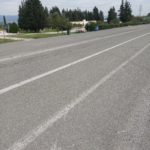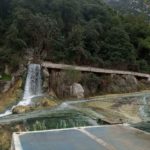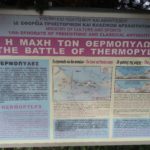Welcome to Thermopylae, the site of one of the most famous battles in history! Named after its hot sulphur springs, this narrow pass in Lamia, Greece, is known as the Hot Gates. Its geothermal wonders and historical records make it a captivating destination for both history enthusiasts and nature lovers.
Key Takeaways:
- Thermopylae is a narrow pass in Lamia, Greece, known as the Hot Gates.
- It is named after its hot sulphur springs and features geothermal wonders.
- The pass is renowned for its historical significance, particularly the Battle of Thermopylae.
- Visitors can explore ancient ruins, a memorial statue of King Leonidas, and a small museum.
- Thermopylae serves as a symbol of bravery and a reminder of the power of defending one’s homeland.
The Battle of Thermopylae: A Last Stand
The Battle of Thermopylae is one of the most memorable events in ancient history. Taking place in 480 BC, it pitted the Greek forces, led by King Leonidas and including the legendary Spartans, against the invading Persian forces commanded by Xerxes. Despite being vastly outnumbered, the Greeks held off the Persians for three days at the narrow pass of Thermopylae, buying crucial time for the Greek city-states to prepare for the imminent invasion.
Under the leadership of King Leonidas, the Spartan warriors fought with unmatched valor, embodying the spirit of bravery and sacrifice. Though ultimately defeated, their resistance left a lasting legacy and inspired countless generations. The Battle of Thermopylae stands as a testament to the indomitable will and determination of those who fought to protect their homeland.
“This is Sparta!” – King Leonidas
The Battle of Thermopylae has been the subject of admiration and fascination throughout history. Its retelling in literature, art, and popular culture, including the iconic film “300,” has further immortalized the heroic stand of King Leonidas and his Spartans. The battle serves as a symbol of courage and the unwavering spirit in the face of overwhelming odds, continuing to inspire people around the world.
| Greek Forces | Persian Forces |
|---|---|
| Spartans | Various Persian tribes and nations |
| Other Greek City-States | Immense Persian army |
The Battle of Thermopylae remains a pivotal event in history, representing Greece’s resistance against foreign invasions. It served as a turning point in the Greco-Persian Wars and highlighted the importance of unity and courage in defending freedom and sovereignty. Today, the story of Thermopylae continues to captivate and remind us of the power of unwavering determination in the face of unimaginable challenges.
The Geographical Importance of Thermopylae
Thermopylae plays a crucial role as a significant land route between Lokris and Thessaly in Greece. This strategic pass has witnessed the movement of traffic and influenced the historical development of the Balkans region. The unique geographical features surrounding Thermopylae, including the coastal floodplain of the Spercheios river and the sloping forested limestone mountains, have shaped the landscape over thousands of years.
The shoreline of the Malian Gulf has experienced changes due to sediment deposition, impacting the width of the pass and the size of the plain around the Spercheios river outlet. These geological transformations have influenced the accessibility and navigability of the area, making Thermopylae an important location during various historical periods.
The Influence of Land Route
The land route offered by Thermopylae has played a significant role in the history of Greece. Not only did it facilitate trade and communication, but it also served as a strategic pathway for military movements. The narrowness of the pass, combined with its geographical characteristics, allowed defenders to control and defend the route, creating challenges for invading forces.
Strategically positioned amidst the natural barriers of the rugged mountains and the sea, Thermopylae became a strategic chokepoint, limiting the movement of armies and navies. The control of this vital land route gave the defenders a distinct advantage, allowing them to hold off superior forces and protect Greece from invasions throughout history.
Understanding the geographical importance of Thermopylae provides valuable insights into the historical significance and enduring legacy of this famous location.
| Geographical Features | Influence |
|---|---|
| Coastal floodplain of the Spercheios river | Affects the width of the pass and the size of the plain around the Spercheios river outlet |
| Sloping forested limestone mountains | Forms natural barriers, making it challenging for invading forces |
| Changing shoreline of the Malian Gulf | Impacts the accessibility and navigability of the area |
The Significance of Thermopylae in History
In ancient times, the region known as Thermopylae was called Malis, named after the Malian Greeks who inhabited the area. It held great importance in Greek history and was home to the ancient city of Trachis and the revered Temple of Demeter Amphictyonis. Throughout history, Thermopylae has been the site of numerous significant battles, ranging from the Greco-Persian Wars to the Byzantine-Bulgarian Wars. It has witnessed invasions and conflicts that have shaped the course of history.
One notable event that took place at Thermopylae was the Battle of Thermopylae itself, where King Leonidas and his Spartan warriors fiercely defended against the invading Persian forces led by Xerxes. This battle has become legendary for its portrayal of courage, sacrifice, and the determination to protect one’s homeland against overwhelming odds.
Thermopylae’s historical significance extends beyond the famous battle. It also played a pivotal role in the Gallic invasion of the Balkans and the Roman-Seleucid Wars. The region’s strategic location and its status as a decisive passage between geographical regions made it a focal point for military campaigns and territorial disputes throughout ancient times.
The Significance of Thermopylae in Greek History
The historical importance of Thermopylae is further emphasized by its association with the Amphictyony, a collective religious and political organization of ancient Greek tribes. The Amphictyony held important religious ceremonies at Thermopylae, contributing to the site’s cultural and spiritual significance in Greek society.
Thermopylae, with its rich history of ancient battles, invasions, and cultural prominence, stands as a testament to the enduring legacy of the region. It continues to captivate the imagination of people worldwide, inspiring awe and admiration for the bravery and resilience of those who fought on its hallowed grounds.
The Legacy of Thermopylae
The Battle of Thermopylae and the valiant sacrifice of King Leonidas and his Spartans have left a lasting legacy. This last stand has become an inspiration for people around the world, symbolizing courage and heroism in the face of overwhelming odds. The story of Thermopylae has been immortalized in various forms of media, including literature, art, and popular culture.
“This is where we hold them! This is where we fight!” These iconic words, spoken by Gerard Butler’s portrayal of King Leonidas in the movie “300,” have become ingrained in popular culture. The film itself, based on Frank Miller’s graphic novel, brought the story of Thermopylae to a wider audience and further solidified its place in the collective consciousness as a tale of bravery.
Thermopylae continues to inspire people of all ages. It serves as a reminder that even in the face of seemingly insurmountable obstacles, standing up for what you believe in is worth the sacrifice. The legacy of Thermopylae lives on, encouraging individuals to show resilience and determination in their own lives.
“Go tell the Spartans, stranger passing by, that here obedient to their laws we lie.” – Simonides
The famous quote by Simonides, an ancient Greek poet, serves as a lasting tribute to the valiant sacrifice of the Spartans at Thermopylae. It is a powerful reminder of their unwavering dedication and loyalty to their homeland.
The Influence of Thermopylae in Popular Culture
The Battle of Thermopylae has had a significant impact on popular culture, with references and adaptations appearing in various forms of media. It has inspired countless movies, books, and even video games. Films like “The 300 Spartans” and “The Spartan” further cemented the legendary status of the battle, while novels like Steven Pressfield’s “Gates of Fire” delve into the historical details and personal stories of the warriors involved.
The story of Thermopylae continues to captivate audiences, resonating with its themes of courage, sacrifice, and the struggle for freedom. It serves as a powerful reminder of the indomitable human spirit and our capacity for bravery in the face of adversity.
| Popular Cultural References | Media Type |
|---|---|
| “300” (2006) | Movie |
| “Gates of Fire” by Steven Pressfield | Novel |
| “The 300 Spartans” (1962) | Movie |
| “The Spartan” (2022) | Movie |
Exploring Thermopylae Today
Thermopylae, also known as the Hot Gates, is not just a site of historical significance, but also a fascinating place to explore today. Visitors to Thermopylae can immerse themselves in the rich history of the region while experiencing its natural beauty. Here are some highlights of what you can discover when visiting this iconic location:
Ancient Ruins
Thermopylae is home to ancient ruins that provide glimpses into its past. As you explore the area, you can see remnants of the original walls and fortifications that were once instrumental in defending against invasions. Walking through the ruins, you can truly sense the history that unfolded within these walls.
Memorial Statue
A visit to Thermopylae would not be complete without paying homage to King Leonidas and his brave warriors. A memorial statue stands proudly in honor of their valiant sacrifice. This iconic statue serves as a reminder of the courage and heroism displayed during the Battle of Thermopylae.
Small Museum
In addition to the ancient ruins and memorial statue, Thermopylae also boasts a small museum. Here, you can delve deeper into the history of the region, gaining valuable insights into the battle and the important role Thermopylae played in Greek history. The museum’s exhibits offer a comprehensive look at the events that unfolded at this historic site.
Visiting Thermopylae provides a unique opportunity to step back in time and connect with the past. Whether you are a history enthusiast or simply curious about the legendary Battle of Thermopylae, this iconic location offers a captivating experience that is sure to leave a lasting impression.
Conclusion
Thermopylae, known as the Hot Gates, holds great historical significance as the site of the famous Battle of Thermopylae. This narrow pass in Lamia, Greece, was where King Leonidas and his Spartan warriors bravely stood against the invading Persian forces. Their valiant sacrifice has become legendary, symbolizing courage and heroism.
Today, visitors can still explore Thermopylae and experience its historical importance. Among the ancient ruins, there stands a memorial statue of King Leonidas, a testament to the bravery of those who fought in this famous battle. Additionally, a small museum provides valuable information about the battle and the region’s history.
Thermopylae is not only a place of historical significance but also a reminder of the courage and sacrifice of those who fought to defend their homeland. From their heroic stand, a legacy has emerged that continues to inspire people around the world. This enduring symbol of bravery against overwhelming odds has left an indelible mark on the history of Greece and the hearts of many.
FAQ
Why is Thermopylae called the Hot Gates?
Thermopylae is named after the hot sulphur springs in the area, which have led to its nickname, the Hot Gates.
When did the Battle of Thermopylae take place?
The Battle of Thermopylae took place in 480 BC.
Who were the leaders in the Battle of Thermopylae?
King Leonidas led the Greek forces, while Xerxes led the invading Persian forces.
What is the significance of Thermopylae in Greek history?
Thermopylae was an important region in Greek history and was home to the ancient city of Trachis and the Temple of Demeter Amphictyonis.
How long did the Greeks hold off the Persians at Thermopylae?
The Greeks held off the Persians for three days at the narrow pass.
How has the geography of Thermopylae changed over time?
The shoreline has advanced due to sediment deposition, and the level of the Malian Gulf has changed, which has affected the width of the pass and the size of the plain around the Spercheios river outlet.
How has the Battle of Thermopylae been immortalized in popular culture?
The battle has been depicted in literature, art, and the famous film “300”, and it continues to inspire people as a symbol of bravery against overwhelming odds.
Can visitors still explore Thermopylae today?
Yes, visitors can still explore the area and visit ancient ruins, a memorial statue of King Leonidas, and a small museum that provides information about the battle and the history of the region.
Source Links
- https://en.wikipedia.org/wiki/Thermopylae
- https://en.wikipedia.org/wiki/Battle_of_Thermopylae
- https://offbeatgreece.com/visit-thermopylae/
Author Profile
-
Welcome to e-thermopyles.gr, your gateway to the fascinating world of Thermopylae and the legendary Spartans. My name is George Margaritis, and I’m the proud owner and writer behind this website.
A Passion for History and the Spartan Legacy
I consider myself fortunate to call the historic site of Thermopylae my home. From a young age, I was captivated by history, and in particular, the incredible tale of the Battle of Leonidas in Thermopylae. The valiant stand of King Leonidas and his 300 Spartans against overwhelming odds has left an indelible mark on the annals of history.
As I delved deeper into this captivating story, my fascination only grew. The bravery, strategy, and sacrifice of those Spartan warriors resonated with me, and I wanted to share this rich history with the world. That’s why I created e-thermopyles.gr, a platform dedicated to exploring and uncovering the depths of knowledge surrounding Thermopylae and the Spartans.
Latest entries
 HistoryOctober 31, 2023Exploring Why is the Battle of Thermopylae Interesting
HistoryOctober 31, 2023Exploring Why is the Battle of Thermopylae Interesting GuidesOctober 31, 2023Your Guide to the Athens to Thermopylae Train Journey
GuidesOctober 31, 2023Your Guide to the Athens to Thermopylae Train Journey GuidesOctober 31, 2023Uncover the Mystery: Where is Thermopylae Today?
GuidesOctober 31, 2023Uncover the Mystery: Where is Thermopylae Today? GuidesOctober 31, 2023Uncover History by Visiting Thermopylae – A Travel Guide
GuidesOctober 31, 2023Uncover History by Visiting Thermopylae – A Travel Guide






